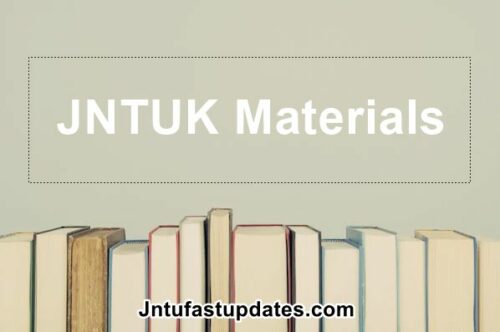JNTUK R16 3-2 Power Electronic Controllers & Drives Material PDF Download
Students those who are studying JNTUK R16 EEE Branch, Can Download Unit wise R16 3-2 Power Electronic Controllers & Drives (PECD) Material/Notes PDFs below.

JNTUK R16 3-2 Power Electronic Controllers & Drives Material PDF Download
Preamble: This course is an extension of power electronics applications to electric drives. This course covers in detail the basic and advanced speed control techniques using power electronic converters that are used in industry. It is equally important to understand the four quadrant operation of electric drives and slip power recovery schemes in induction motors.
OBJECTIVES:
- To learn the fundamentals of electric drive and different electric braking methods.
- To analyze the operation of three phase converter controlled dc motors and four quadrant operation of dc motors using dual converters.
- To discuss the converter control of dc motors in various quadrants.
- To understand the concept of speed control of induction motor by using AC voltage controllers and voltage source inverters.
- To learn the principles of static rotor resistance control and various slip power recovery schemes.
- To understand the speed control mechanism of synchronous motors
UNIT-1
Fundamentals of Electric Drives Electric drive – Fundamental torque equation – Load torque components – Nature and classification of load torques – Steady state stability – Load equalization– Four quadrant operation of drive (hoist control) – Braking methods: Dynamic – Plugging – Regenerative methods.
UNIT–2
Controlled Converter Fed DC Motor Drives 1-phase half and fully controlled converter fed separately and self-excited DC motor drive – Output voltage and current waveforms – Speed-torque expressions – Speed-torque characteristics –– Principle of operation of dual converters and dual converter fed DC motor drives -Numerical problems.
UNIT–3
DC–DC Converters Fed DC Motor Drives Single quadrant – Two quadrant and four quadrant DC-DC converter fed separately excited and self-excitedDC motors – Continuous current operation– Output voltage and current waveforms – Speed–torque expressions – Speed–torque characteristics –Four quadrant operation – Closed loop operation (qualitative treatment only).
UNIT–4
Stator side control of 3-phase Induction motor Drive Stator voltage control using 3-phase AC voltage regulators – Waveforms –Speed torque characteristics– Variable Voltage Variable Frequency control of induction motor by PWM voltage source inverter – Closed loop v/f control of induction motor drives (qualitative treatment only).
Download UNIT-4 Material PDF | Reference-2
UNIT–5
Rotor side control of 3-phase Induction motor Drive Static rotor resistance control – Slip power recovery schemes – Static Scherbius drive – Static Kramer drive – Performance and speed torque characteristics – Advantages –Applications.
Download UNIT-5 Material PDF | Reference-2
UNIT–6
Control of Synchronous Motor Drives Separate control & self-control of synchronous motors – Operation of self-controlled synchronous motors by VSI– Closed Loop control operation of synchronous motor drives (qualitative treatment only).–Variable frequency control–Pulse width modulation.
Download UNIT-6 Material PDF | Reference-2
TEXT BOOKS:
- Fundamentals of Electric Drives – by G K DubeyNarosa Publications
- Power Semiconductor Drives, by S.B.Dewan, G.R.Slemon, A.Straughen, WileyIndia Edition.
REFERENCE BOOKS:
- Electric Motors and Drives Fundamentals, Types and Apllications, by Austin Hughes and Bill Drury, Newnes.
- Thyristor Control of Electric drives – VedamSubramanyam Tata McGraw Hill Publications.
- Power Electronic Circuits, Devices and applications by M.H.Rashid, PHI
- Power Electronics handbook by Muhammad H.Rashid, Elsevier.
OUTCOMES:
- Explain the fundamentals of electric drive and different electric braking methods.
- Analyze the operation of three phase converter fed dc motors and four quadrant operations of dc motors using dual converters.
- Describe the converter control of dc motors in various quadrants of operation
- Know the concept of speed control of induction motor by using AC voltage controllers and voltage source inverters.
- Differentiate the stator side control and rotor side control of three phase induction motor.
- Explain the speed control mechanism of synchronous motors

320-x100(1).gif)
